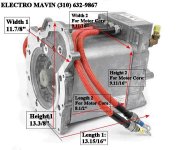Thanks Dave,
Yes, Eric is the guy I mentioned previously that has made this conversion in his Passat. I want to do a similar thing. I wasn't able to find out for sure if the SSD drives used the FOC to get the full torque at zero RPM so if you can find out for sure ie. referenced in the manual or a paper, that would be great.
With this industrial AC drive concept, I know that I am not breaking new ground. It is the only way I can think of doing this project, learning something new, and challenging myself. I like the idea of regen and it should extend the car's range a bit. It is hard enough to get one AC motor to spin much less four of them! Folks are doing some pretty interesting things out there.
I researched the Emerson drives that Btalbot mentioned. They are very modular and look like they are set up to change the output stage to create more power while still maintaining a similar, if not identical controller. I bought one on Ebay for $285 and I am going to tinker with it. Most of the drive manufacturers don't give schematics (although Hitachi does for their SJ series) so I'll have to reverse engineer where the IGBT triggers are and the current, voltage and encoder feedback.
Here is the motor I am going to use.
-Rjay
-Rjay

Yes, Eric is the guy I mentioned previously that has made this conversion in his Passat. I want to do a similar thing. I wasn't able to find out for sure if the SSD drives used the FOC to get the full torque at zero RPM so if you can find out for sure ie. referenced in the manual or a paper, that would be great.
With this industrial AC drive concept, I know that I am not breaking new ground. It is the only way I can think of doing this project, learning something new, and challenging myself. I like the idea of regen and it should extend the car's range a bit. It is hard enough to get one AC motor to spin much less four of them! Folks are doing some pretty interesting things out there.
I researched the Emerson drives that Btalbot mentioned. They are very modular and look like they are set up to change the output stage to create more power while still maintaining a similar, if not identical controller. I bought one on Ebay for $285 and I am going to tinker with it. Most of the drive manufacturers don't give schematics (although Hitachi does for their SJ series) so I'll have to reverse engineer where the IGBT triggers are and the current, voltage and encoder feedback.
Here is the motor I am going to use.
-Rjay
-Rjay







